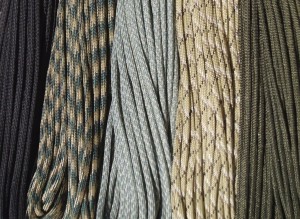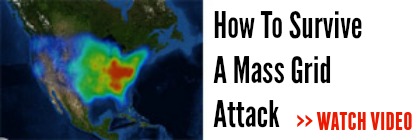 If you’ve been to a gun show or outdoor expo recently, then you probably noticed that tons of guides and experts were wearing bracelets made from a thin piece of rope, AKA “paracord.”
If you’ve been to a gun show or outdoor expo recently, then you probably noticed that tons of guides and experts were wearing bracelets made from a thin piece of rope, AKA “paracord.”
Paracord, in case you’re not aware, is an extremely strong form of nylon rope designed for parachutes — hence the name.
These bracelets are actually more than just a fashion statement. When unwound, these bracelets are a powerful survival resource.
Because they were designed to be used in life-or-death situations (parachutes) you can count on these cords being super strong.
 These paracord bracelets, keychains, and necklaces (you can find them for sale in various forms) have hundreds of uses… handcuffs, traps, rifle slings, etc.
These paracord bracelets, keychains, and necklaces (you can find them for sale in various forms) have hundreds of uses… handcuffs, traps, rifle slings, etc.
To illustrate just how versatile this small rope is, I decided to come up with a quick list of 25 uses. Here’s what I came up with:
- Makeshift belt
- Tie-downs for tents, tarps, cargo
- Hang food in trees away from wildlife
- To tie a holster/sheath to your leg
- Replacement boot laces
- Clothesline
- Tie bundles of kindling
- Carry strap for your compass
- Hang a lantern
- Makeshift net
- Makeshift hammock
- Splint broken fingers
- Wrap around your hands for emergency gloves
- Rifle sling
- Stringer (for fish)
- Hang deer and game for dressing
- Tow rope (braid several strands together)
- Pull cord for small engine (lawnmower, chainsaw, etc.)
- Replacement grip for hand tools
- Emergency tourniquet
- Trip wire
- Dog/pet leash
- Makeshift handcuffs
- Trotline or jug line
- Repair broken straps

Better forewarned…and forearmed..
Survival Braclets- 25 feet of cord woven into a braclet.
Flex cuff cutter
How about as a garot (spelling might be wrong…used as a choking weapon)?
As as “foot tangle and alarm” with tin cans tied to stakes driven into the ground when one does not have a means to have a mine field?
As a camo curtain or pull rod over a door or window?
How about as a webbed weave holding cover over a snare pit?
As u know there are 5 strands of string in paracord . They can be pulled out and used for fishing line. When making a bracelet u can place a small fish hook inside the bracelet weve.
Lash a knife to a pole to make a spear
Tie several poles together to make a raft
Snare to catch small game
Make a mesh to fit end of pole to catch fish
Wick for lamp
Make a hammock
I would strongly discourage the use of paracord for a touniquet. The narrow profile can cause severe soft tissue damage and there are so many other readily available wider items that would work better. No disrespect intended just my view.
I received one of your paracord bracelets but NO INSTRUCTIONS on how to “unravel” it. Can’t figure out how to get to the cords itself. Could you post on one of your daily posts please> Thanks, and thanks for all your great tips.
String for a homemade bow and tie arrowheads on sticks.
The use of paracord as a tourniquet is something to be very careful doing. This is especially true on legs. Having done research with the Army Medical Department, we discovered in our testing of commercial products that there is a specific ratio of size of the tourniquet to the size of the limb (I can’t quote it) – however, for legs, the size of the tourniquet in terms of width, had to be something on the order of 2 inches (again, I’m not precisely sure of exact size) – BUT, the very thin nature of paracord will NOT stem the flow of blood from a major vessel bleed on a leg. It might do well on lower arm – but, the proper placement of the tourniquet is NOT below the elbow – it’s above the elbow.
The main point here is that if one “believes” they are using paracord in a life-saving situation in the proper manner, they can fail to stem the flow of blood – and the patient will die. Soft tissue damage is NOT the primary concern – the fact that you are using a tourniquet in the first place means there has been something really bad happen. Wider items ARE preferable to accomplish the purpose of a tourniquet – stopping the flow of blood.
Correct om the tourniquet advice. Good call.
Given enough paracord you can macrame’ just about anything you might need like a firewood tote, bag for foraging, extra or wrap. Your choices are nearly limitless. If you do not know how to macrame’, learn! Unlike weaving, you do not need a loom.
1 Use as an insulator on the ends of a field built radio antenna.
2 Tie a knot on one end of a short lenght of pc to make a makeshift snake bore cleaner for Pistol, Rifle or tie a small rag
into the knot for use in cleaning a Shotgun.
3 Use to make Snowshoes.
4 Brade three strands together, weave through you car/truck driving wheels to make an emergancy snow tire device.
The small strands can be used as suture material in necessary. Not ideal but will work.
you’d better have it already done or you’ll never get it macramed in time to stop a bleed out.